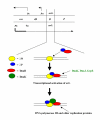Stress responses and replication of plasmids in bacterial cells
- PMID: 12076355
- PMCID: PMC115368
- DOI: 10.1186/1475-2859-1-2
Stress responses and replication of plasmids in bacterial cells
Abstract
Plasmids, DNA (or rarely RNA) molecules which replicate in cells autonomously (independently of chromosomes) as non-essential genetic elements, play important roles for microbes grown under specific environmental conditions as well as in scientific laboratories and in biotechnology. For example, bacterial plasmids are excellent models in studies on regulation of DNA replication, and their derivatives are the most commonly used vectors in genetic engineering. Detailed mechanisms of replication initiation, which is the crucial process for efficient maintenance of plasmids in cells, have been elucidated for several plasmids. However, to understand plasmid biology, it is necessary to understand regulation of plasmid DNA replication in response to different environmental conditions in which host cells exist. Knowledge of such regulatory processes is also very important for those who use plasmids as expression vectors to produce large amounts of recombinant proteins. Variable conditions in large-scale fermentations must influence replication of plasmid DNA in cells, thus affecting the efficiency of recombinant gene expression significantly. Contrary to extensively investigated biochemistry of plasmid replication, molecular mechanisms of regulation of plasmid DNA replication in response to various environmental stress conditions are relatively poorly understood. There are, however, recently published studies that add significant data to our knowledge on relations between cellular stress responses and control of plasmid DNA replication. In this review we focus on plasmids derived from bacteriophage lambda that are among the best investigated replicons. Nevertheless, recent results of studies on other plasmids are also discussed shortly.
Figures



Similar articles
-
Replication and control of circular bacterial plasmids.Microbiol Mol Biol Rev. 1998 Jun;62(2):434-64. doi: 10.1128/MMBR.62.2.434-464.1998. Microbiol Mol Biol Rev. 1998. PMID: 9618448 Free PMC article. Review.
-
Hfq protein deficiency in Escherichia coli affects ColE1-like but not λ plasmid DNA replication.Plasmid. 2014 May;73:10-5. doi: 10.1016/j.plasmid.2014.04.005. Epub 2014 May 5. Plasmid. 2014. PMID: 24811974
-
Replication of plasmids during bacterial response to amino acid starvation.Plasmid. 1999 Jan;41(1):1-16. doi: 10.1006/plas.1998.1377. Plasmid. 1999. PMID: 9887302 Review.
-
Replication and amplification of lambda plasmids in Escherichia coli during amino acid starvation and limitation.FEMS Microbiol Lett. 1997 Aug 1;153(1):151-7. doi: 10.1111/j.1574-6968.1997.tb10476.x. FEMS Microbiol Lett. 1997. PMID: 9252584
-
DnaA-mediated regulation of phage lambda-derived replicons in the absence of pR and Cro function.Virology. 1998 Sep 15;249(1):98-107. doi: 10.1006/viro.1998.9319. Virology. 1998. PMID: 9740781
Cited by
-
Antibiotic resistance gene dynamics in the commensal infant gut microbiome over the first year of life.Sci Rep. 2024 Aug 12;14(1):18701. doi: 10.1038/s41598-024-69275-w. Sci Rep. 2024. PMID: 39134593 Free PMC article.
-
Metagenomic analysis reveals significant changes of microbial compositions and protective functions during drinking water treatment.Sci Rep. 2013 Dec 19;3:3550. doi: 10.1038/srep03550. Sci Rep. 2013. PMID: 24352003 Free PMC article.
-
Plasmids, a molecular cornerstone of antimicrobial resistance in the One Health era.Nat Rev Microbiol. 2024 Jan;22(1):18-32. doi: 10.1038/s41579-023-00926-x. Epub 2023 Jul 10. Nat Rev Microbiol. 2024. PMID: 37430173 Review.
-
Switch from theta to sigma replication of bacteriophage lambda DNA: factors involved in the process and a model for its regulation.Mol Genet Genomics. 2007 Jul;278(1):65-74. doi: 10.1007/s00438-007-0228-y. Epub 2007 Mar 22. Mol Genet Genomics. 2007. PMID: 17377819
-
Transformed Salmonella typhimurium SL7207/pcDNA-CCOL2A1 as an orally administered DNA vaccine.AMB Express. 2024 Jan 9;14(1):6. doi: 10.1186/s13568-023-01650-8. AMB Express. 2024. PMID: 38196027 Free PMC article.
References
-
- Helinski DR, Toukdarian A, Novick RP. Replication control and other stable maintenance mechanisms of plasmids. In: Neidhardt FC, Curtiss III R, Ingraham J, Lin ECC, Low KB, Magasanik B, Reznikoff WS, Riley M, Schaechter M, Umbarger H, editor. Escherichia coli and Salmonella: cellular and molecular biology. Washington DC, American Society for Microbiology; 1996. pp. 2295–2324.
-
- Chattoraj DK. Control of plasmid DNA replication by iterons: no longer paradoxical. Mol Microbiol. 2000;37:467–476. - PubMed
-
- Del Solar G, Espinosa M. Plasmid copy number control: an ever-growing story. Mol Microbiol. 2000;37:492–500. - PubMed
-
- Gerdes K, Moller-Jensen J, Jensen RB RB. Plasmid and chromosome partitioning: surprises from phylogeny. Mol Microbiol. 2000;37:455–466. - PubMed
LinkOut - more resources
Full Text Sources

